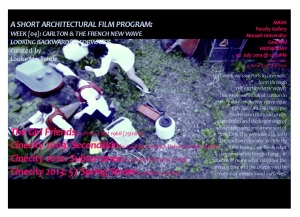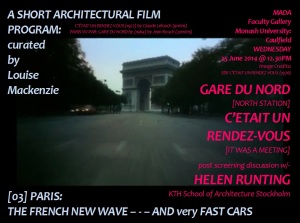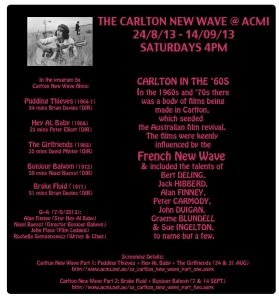Wednesday 02 July 2014 @ 12:30PM
A SHORT ARCHITECTURAL FILM PROGRAM
WEEK [04]: CARLTON & THE FRENCH NEW WAVE / LOOKING BACKWARDS & FORWARDS
[FILMS: The Girl Friends, Secondskin, Subterranea & 57 Spring Street / CITY: Melbourne]
Guest speaker: Louise Mackenzie
In the late 1960s and early 70s in Carlton, Melbourne, there was a bunch of films being made that were unashamedly frenchnewwaveques…made cheaply mostly by students this body work seeded the renaissance of the Australian film industry. THE GIRL FRIENDS being made in the nineteen sixties indicates, in looking at Carlton today, the massive changes that have taken place since and where taking place at the time the film was made. The next three films are from The Cinecity Project and suggest change as well – places lived in, some abandoned and some regained, some with adjusted uses, some enabling ways of life lived, some thinking back and moving on.
THE GIRL FRIENDS (1968) Carlton, Melbourne…commission flats…terrace houses…the nineteen sixties _“These boots were made for Walking”… and dancing…
SECONDSKIN (2009) Once was home…home again
SUBTERRANEA (2010) Car parks…as art spaces…as film space as art
57 SPRING STREET (2013) Cinematic long section of a life in place in time
Wednesday 02 July 2014 @ 12.30pm / MADA Gallery Building G Caulfield Monash University
Film: The Girl Friends by Peter Elliot 1968 (25mins)
Film: Cinecity: Secondskin by Georgia Forbes & Lisha Corcoran 2009 (1mins)
Film: Cinecity: Subterranea By Lindy Fetherston 2010 (1mins)
Film: Cinecity: 57 Spring Street By ShMoJo 2013 (1min)




![WEEK [02] MODERNITY 20-60 _ LE CORBUSIER & THE EAMES](https://macklouise.files.wordpress.com/2014/05/week-02-modernity-20-60-_-le-corbusier-the-eames.jpg?w=300&h=218)

